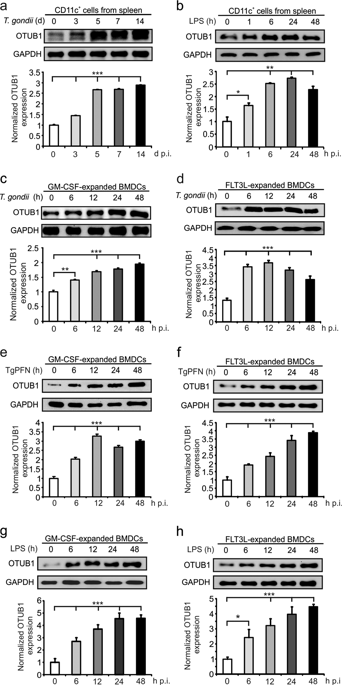Cellular & Molecular Immunology ( IF 21.8 ) Pub Date : 2020-02-05 , DOI: 10.1038/s41423-020-0362-6 Floriana Mulas 1, 2 , Xu Wang 1, 2, 3 , Shanshan Song 1 , Gopala Nishanth 1, 2 , Wenjing Yi 1, 2 , Anna Brunn 4 , Pia-Katharina Larsen 5 , Berend Isermann 6 , Ulrich Kalinke 5, 7 , Antonio Barragan 8 , Michael Naumann 9 , Martina Deckert 4 , Dirk Schlüter 1, 2, 7

|
Dendritic cells (DCs) are indispensable for defense against pathogens but may also contribute to immunopathology. Activation of DCs upon the sensing of pathogens by Toll-like receptors (TLRs) is largely mediated by pattern recognition receptor/nuclear factor-κB (NF-κB) signaling and depends on the appropriate ubiquitination of the respective signaling molecules. However, the ubiquitinating and deubiquitinating enzymes involved and their interactions are only incompletely understood. Here, we reveal that the deubiquitinase OTU domain, ubiquitin aldehyde binding 1 (OTUB1) is upregulated in DCs upon murine Toxoplasma gondii infection and lipopolysaccharide challenge. Stimulation of DCs with the TLR11/12 ligand T. gondii profilin and the TLR4 ligand lipopolysaccharide induced an increase in NF-κB activation in OTUB1-competent cells, resulting in elevated interleukin-6 (IL-6), IL-12, and tumor necrosis factor (TNF) production, which was also observed upon the specific stimulation of TLR2, TLR3, TLR7, and TLR9. Mechanistically, OTUB1 promoted NF-κB activity in DCs by K48-linked deubiquitination and stabilization of the E2-conjugating enzyme UBC13, resulting in increased K63-linked ubiquitination of IRAK1 (IL-1 receptor-associated kinase 1) and TRAF6 (TNF receptor-associated factor 6). Consequently, DC-specific deletion of OTUB1 impaired the production of cytokines, in particular IL-12, by DCs over the first 2 days of T. gondii infection, resulting in the diminished production of protective interferon-γ (IFN-γ) by natural killer cells, impaired control of parasite replication, and, finally, death from chronic T. encephalitis, all of which could be prevented by low-dose IL-12 treatment in the first 3 days of infection. In contrast, impaired OTUB1-deficient DC activation and cytokine production by OTUB1-deficient DCs protected mice from lipopolysaccharide-induced immunopathology. Collectively, these findings identify OTUB1 as a potent novel regulator of DCs during infectious and inflammatory diseases.
中文翻译:

去泛素酶 OTUB1 通过稳定 UBC13 来增强感染和炎症中树突状细胞中 NF-κB 依赖性免疫反应
树突状细胞(DC)对于防御病原体是必不可少的,但也可能有助于免疫病理学。 Toll 样受体 (TLR) 感知病原体后 DC 的激活很大程度上是由模式识别受体/核因子-κB (NF-κB) 信号传导介导的,并且取决于相应信号分子的适当泛素化。然而,所涉及的泛素化和去泛素化酶及其相互作用尚不完全清楚。在这里,我们揭示了在鼠弓形虫感染和脂多糖攻击后,去泛素酶 OTU 结构域、泛素醛结合 1 (OTUB1) 在 DC 中上调。用 TLR11/12 配体刚地弓形虫profilin 和 TLR4 配体脂多糖刺激 DC,可诱导 OTUB1 感受态细胞中 NF-κB 活化增加,导致白细胞介素 6 (IL-6)、IL-12 和肿瘤水平升高坏死因子 (TNF) 的产生,在 TLR2、TLR3、TLR7 和 TLR9 的特异性刺激下也观察到了这一现象。从机制上讲,OTUB1 通过 K48 连接的去泛素化和 E2 结合酶 UBC13 的稳定来促进 DC 中 NF-κB 的活性,从而导致 IRAK1(IL-1 受体相关激酶 1)和 TRAF6(TNF 受体相关激酶 1)和 TRAF6(TNF 受体相关激酶)的 K63 连接的泛素化增加。相关因素6)。因此,在弓形虫感染的前 2 天,DC 特异性删除 OTUB1 会损害 DC 细胞因子的产生,特别是 IL-12,从而导致天然保护性干扰素-γ (IFN-γ) 的产生减少。杀伤细胞、寄生虫复制控制受损,最后因慢性T.脑炎,所有这些都可以在感染的前 3 天内通过低剂量 IL-12 治疗来预防。相比之下,OTUB1 缺陷型 DC 的激活和 OTUB1 缺陷型 DC 产生细胞因子的受损可保护小鼠免受脂多糖诱导的免疫病理学影响。总的来说,这些发现表明 OTUB1 是传染性和炎症性疾病期间 DC 的一种有效的新型调节剂。











































 京公网安备 11010802027423号
京公网安备 11010802027423号